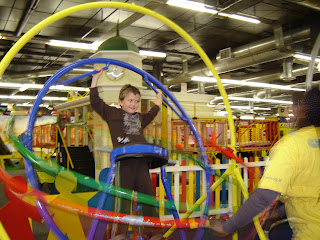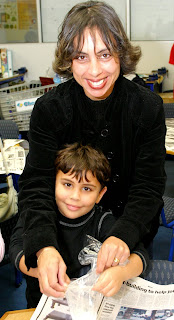
As the seating in the arena slowly fills up the children can't hide their giddy anticipation. Neither can Ken Lacovara, above, chattering away about dinosaurs and digs. Admittedly, he has a soul patch on his chin, a beer and a couple of graduate students, which marks him out from the majority of enthusiasts here to see Walking with Dinosaurs: The Live Experience. But there's no mistaking the kinship between the professor of geology and palaeontology from Drexel University, Philadelphia, and the children around him. "Everybody I know in the field wanted to do this since they were very young," he says, looking around. "You never know what future scientists might be in the audience."
The stage show now touring America — watched by Nature and Lacovara at Philadelphia's Wachovia Spectrum sports arena in August — was inspired by the BBC documentary series, which, according to Lacovara, set a gold standard for edutainment (see 'Origin of a Species'). Using computer animation, animatronics and the authoritative tones of the actor Kenneth Branagh, the series told the tale of the dinosaurs' 160-million-year lease on Earth. The programme was stunning to watch yet stuck close enough to scientific understanding not to upset an expert. At least, not Lacovara. The $20-million stage show has a lot to live up to, and Lacovara's excitement — especially over the prospect of a fully fleshed-out brachiosaurus — is tinged with scepticism. How well can a theatrical presentation relay natural history? Will spectacle triumph at the expense of information?
The house lights dim and a booming voice reminds the crowd that, as cell phones and pagers didn't exist 65 million years ago, they should be turned off. Score one for realism. 'Huxley', a palaeontological P. T. Barnum strides on to the stage to serve as our guide and scale bar. He bends down by a nest from which plateosaurus hatchlings emerge, in the form of squirming green hand-puppets. The eggs, Lacovara notes, aren't shaped quite right — too "chickeny" — but his criticism is cut short by lilliensternus. A two-metre-tall carnivore enters the arena. Actually, it's a suit worn by an actor with the mettle to carry 40 kilograms of foam, lycra and animatronics on his back and yet still look nimble. Once you learn to ignore the craftily camouflaged extra set of human legs, it's pretty convincing.
Prosauropod and predator settle into a carefully choreographed stand-off.
In the interest of conflict, a full-grown plateosaurus appears next, eager to defend its babies. This large dinosaur is a puppet, operated by three people. One drives a slim car camouflaged beneath the dinosaur; two others are in a control room moving its neck, tail, jaws and the like by manipulating a smaller version, evocatively known as a voodoo rig. Prosauropod and predator settle into a carefully choreographed stand-off. The slow, deliberate tempo is the result of much trial and error, Matthew McCoy, the head of puppetry, later explains. McCoy tells the tale of a tragic show in Sydney, Australia, in which Tyrannosaurus rex's head fell off after a tight turn at high speed. The audience was sympathetic, he says with some gratitude, but the troupe learned its lesson.
In addition to slowing down the action in later shows, the team built a spare T. rex. With 15 dinosaurs taking the stage every night, losing one wouldn't necessarily stop the show, but turning up in front of hundreds of children without a working T. rex just doesn't cut it. "We might as well just go home," says McCoy. There are contingency plans for other disasters, too. Had lilliensternus been toppled by plateosaurus's heavy whiplike tail, for example, he would have needed help getting back up. That, says McCoy, is when they send in the dinosaur clowns.
No disasters strike in Philadelphia. After several minutes of a mock battle and trotting about, lilliensternus and plateosaurus dutifully leave the stage, and Huxley eases the crowd through geological time into the Jurassic period. Bright inflatable plants explode around the stage. Lacovara gleefully elbows one of his students; he thinks giving a round of applause to the Jurassic just for starting is pretty amusing.
With the Jurassic period come the brachiosaurs. The young one is perhaps two storeys tall; the adult, more than ten metres. They make an impressive pair as they stretch their long necks deep into the stands, delighting the audience. As one of them almost lays its head in Lacovara's lap, he notes that a full-grown adult would have been a bit taller, but he's still impressed. The palaeontologist on stage rattles off statistics about the beast, which may have weighed as much as 40 tonnes. The expert in the stands notes, with a mischievous grin, that the titanosaur his group is excavating in Patagonia weighed 60.
But despite a little professional one-upmanship, Lacovara likes the show. During the intermission, he confers with his students, who agree that it doesn't pull any educational punches. "It's just packed full of content," Lacovara says, noting that it introduces concepts such as deep time, plate tectonics, climate change and evolution: all ingredients, he says, that presented too dryly would spell certain death.
This concept brings us ineluctably to the show's finale. In the climactic Late Cretaceous, rife with volcanic drama (cue the light show), a T. rex mother and son take the stage triumphantly. After some play-fighting with ankylosaurus and torosaurus, they turn their attentions to the crowd. While baby rex, another actor in a heavy dino suit, mugs for the crowd, mum is scaring the life out of them. A blonde boy just behind Lacovara chats nervously with his father about the seating arrangement as the T. rex approaches. "No Daddy, don't tell him I'm here."
A bright strobe with booming audio represents the extraterrestrial coup de grâce at the end of the Cretaceous. The dinos exit, the plants deflate, and bows are taken. The crowd drains from the Spectrum, and the children are laden with bright and blinking palaeoparaphernalia. After three more shows, the crew will pack its 27 truckloads of equipment and move on to the next stop. Lacovara is beaming, satisfied with the production's portrayal of the work he does. Dinosaurs, he says, are "a gateway drug for the sciences". A lot of kids scored tonight.
























